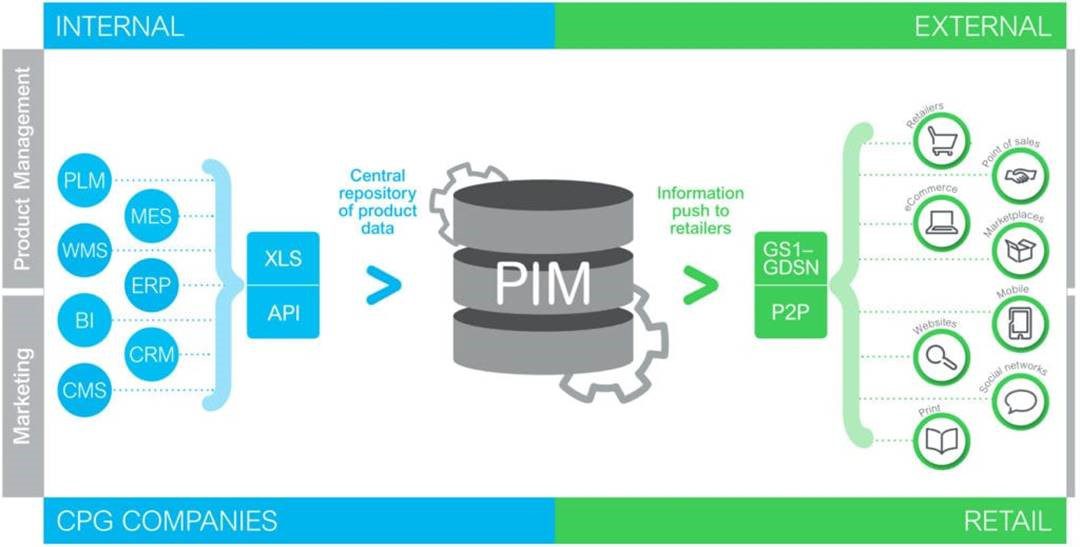We have seen in my previous post, In product data, we trust: the need for a “centralized digital version of the truth” for packaged products, the urgent need for Consumer Packaged Goods manufacturers and retailers to collect correct, qualified and complete information to position the products in top search results, to increase the visibility on e-commerce platforms, and to deliver product transparency for consumer’s buying decision. Additionally, intelligent packaging will enable whole supply chain visibility thanks to QR codes and serialization technology, but this also requires full product data information to be accessible. Consumer Packaged Goods companies manage a huge amount of product information but are often siloed and not well maintained or managed within the organization.
Altogether, it leads to the need for a “centralized digital version of the truth” for products and a near-real-time synchronization so that all channels have current and updated information, based on a retailers’ and manufacturers’ collaborative approach towards standard product data attributes.
But what happens if we do not have a trusted centralized digital version of the truth?
In this context, retailers and manufacturers may need to face the following risks:
- Lost revenue and consumer’s satisfaction
A poor, missing, or incorrect item descriptions and photos will move consumers to find another item, or abandon their carts and switch to another retailer, or return their online purchases, directly attributable to the consumer not receiving what they expected.
- Error handling
30% of the SKUs contains data inaccuracies, causing invoices to be rejected, products not listed and a significant amount of manual effort correcting data errors and omissions on both retailers and manufacturer side.
- Website traffic and search engine optimization
Sub-optimal or incomplete attributes will prevent products to appear in the top search results, reducing buying opportunities.
According to Capgemini, retailers are at a different level of maturity regarding product data requirements: some of them already require more regulated categories of attributes such as certification, allergens, and usage instructions. But, generally, few of them ask for advanced information, such as pricing details, special offers or available promotions, though best-in-class solutions already exist in the market able to manage the pricing.
That means, that manufacturers should choose a solution that handles the different levels of maturity and requirements from retailers.
The Three Imperatives: Data Storage, Data Quality, and Data Sharing
In order to start building a trusted centralized digital version of truth for product information, manufacturers and retailers should consider meeting those three imperatives:
- Data Storage
For retailers, the ownership of product content generally belongs to several functions, including supply chain, category management, and marketing.
Historically, product attributes for CPG companies are “owned” by the supply chain, with marketing enrichment handled as a separate process. E-commerce teams are increasingly playing a leading role in aggregating content from the multitude of internal and external sources. However, this resulted in a siloed channel perspective, resulting in duplication of effort and duplicate content creation, lack of agility, slower time-to-market, and inconsistent consumer experience across channels.
- Data Quality
The growth in the number of SKUs from sub-brands, regional promotions, and product diversification has made the number of products that need basic product information a “mile wide.” Consumer demand has exponentially increased the need for deeper and more detailed data, both structured and unstructured. Companies are being asked to go a mile wide and a mile deep on product information, significantly increasing the level of complexity.
There are increasing industry-driven data quality initiatives facilitated by industry bodies such as GS1. To achieve high-quality product data, companies will need to change the business processes that deal with it. Legacy systems currently in place have been developed for traditional retail processes and are not fit for new business models, and high volumes of data.
- Data Sharing
CPG companies and retailers today procure Product Information from a combination of sources and channels that include GS1, image pools, data pools, and third-party providers.
Furthermore, multiple data sharing mechanisms coexist including Excel files, portals, forms, and unstructured emails, causing errors and calling for management of data redundancy and synchronization.
PIM (Product Information Management) solution, the centralized digital version of truth for retailers and manufacturers
As seen previously, to answer the challenges faced by retailers and manufacturers, a Product Information Management solution is the “single robust source of truth and trust” for the product information across their supply chain.
 To answer the imperatives from the eCommerce, a robust PIM solution with Digital Asset Management (DAM) capabilities is often a pre-requisite for a successful digital commerce business operation enabling to store digital assets in a central repository and distribute them to various channels.
To answer the imperatives from the eCommerce, a robust PIM solution with Digital Asset Management (DAM) capabilities is often a pre-requisite for a successful digital commerce business operation enabling to store digital assets in a central repository and distribute them to various channels.
Further benefits of a Product Information Management (PIM) solution include:
- Real-time and increased collaboration between various internal and external stakeholders (retailers and manufacturers).
- Integration across various existing business systems (such as Manufacturing Execution System, Customer Relationship Management solution, Enterprise Resource Planning, …) for an end-to-end approach.
- Reducing returns thanks to better product content and attribute information.
- Improving the consumer experience by enabling better product information from the manufacturer and retailers’ side.
And finally, in order to cope efficiently with specific retailers’ requirements (from example pricing and promotions) and the increasing number of attributes, a cloud-hosted PIM solution helps manage the growing omnichannel challenges by:
- Combining and synchronizing data from a growing number of sources including those related to the manufacturing of the product.
- Providing interoperability and modularized handling of data.
- Managing unique product content as required by each channel and ensuring data consistency across all channels.
- Handling and integrating unstructured product data.
In conclusion, PIM (Product Information Management) and DAM (Digital Asset Management) solutions bridge the product information gap between sources and consumers, enabling CPG companies to better succeed in today’s omnichannel reality.
Learn everything about this solution at Regain Control of your Consumer Product Data (ii) and download the summary infographic, or contact us.




